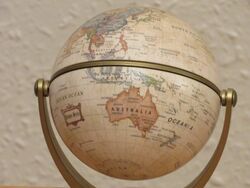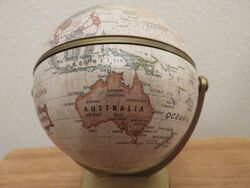- 9,253
- 2,731
That seems way too large to be North America though.DMUA said:The only thing brown I see is an entire Continent
Follow along with the video below to see how to install our site as a web app on your home screen.
Note: This feature may not be available in some browsers.
That seems way too large to be North America though.DMUA said:The only thing brown I see is an entire Continent
Alright, let's do a demonstration:DMUA said:The only thing brown I see is an entire Continent
It's easy to calc thoughDargoo Faust said:The difference should technically be larger since it's a flat line projected onto a sphere, but yeah.
Apologies, I mean when it's a fictional planetoid, which we wouldn't have defined sizes for any given landmass.Ugarik said:Why? We can just use continents
I'm confused.Dargoo Faust said:I guess we could at least solve for the minimum distance needed to be away from the planet for the horizon that is viewed to be equal to the equator; after that I'm not entirely sure how to solve this issue unless we know exactly how high up the POV is.
Again thanks very much for the help, we'll need to update a lot of calcs to fix this.
You'd need to be a certain distance away from the planet for the perspective to not be skewed by sphere geometry, which is kind of hard to prove in calcs where the distance away from Earth isn't given.DMUA said:The point is that using the planet's diameter might not necessarily be entirely void depending on circumstance.
I contacted DontTalkDT and Antoniofer yesterday and bumped my messages today. I hope they can be available.Antvasima said:Politely calling the calc group members, along with DontTalkDT and Antoniofer, here seems best.
No time like the present, I'll get started. It would probably be quicker to start with the more popular verses.Dargoo Faust said:Sure. Although prior to both we should compile all calcs that do either, which is an undertaking in itself.
Where exactly is it stated this is a camera-related problem and not just a simple geometric problem?Kepekley23 said:This is a camera-related problem though. The picture here is taken with a lens that strongly distorts the edges of the planet, thus creating an illusion of an enlarged America. It would have no bearing on, say, the entire planet being shown from afar in a manga panel.
It also works with any spherical objectUgarik said:Not really that's the same good old horizon view limitation. Here's the visualisation


Makes sense.Kepekley23 said:Those Earth pictures are taken with a fish-eye lens, which is well-known to "round" and distort objects at the edges. Not only that, those pictures aren't in real time, they are mashups/composites of several different shots over several months of footage.
Doesn't the example that Ugarik provided (the second, not the first), demonstrate that even when a full circular "globe" is visible there can still be issues?Kepekley23 said:The perspective and distance between the Point of View and the planet are part of the problem, but that's solely in the cases where we use shos that are very close to the ground and by all means are ******-up curvature, which, as I said on the very post you responded to, I agree shouldn't be used.